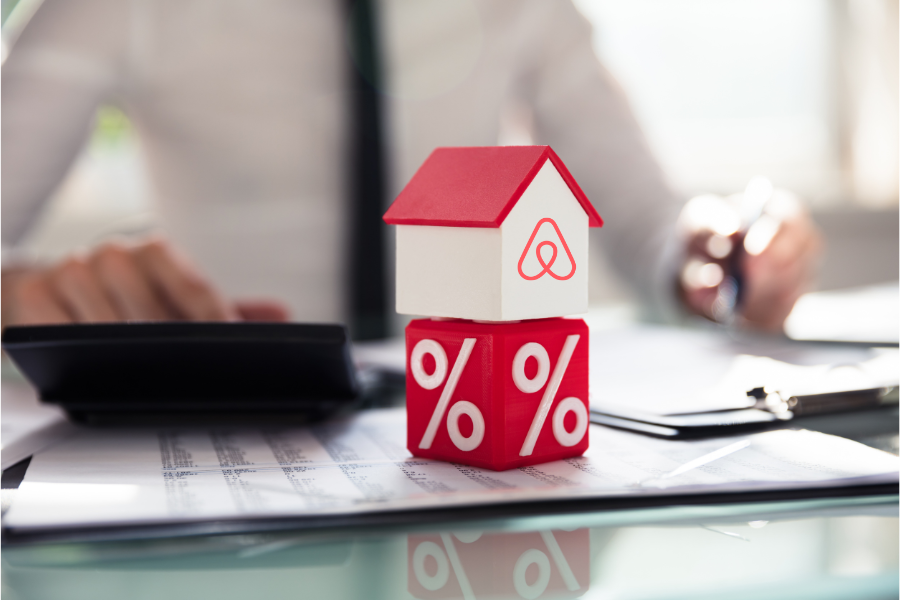Table of Contents
Updated on: September 3, 2025
Listing on Airbnb (or any other OTA) comes with costs that can eat into your earnings. The main one? Host fees. They cover things like running the platform, marketing, and general upkeep. Nothing surprising there – but if you don’t factor them in, your profit margins shrink fast, especially if you’re managing a handful of properties.
So what’s an OTA anyway? Think of it as the middleman between you and the guest – Airbnb, Booking.com, Vrbo, they all fall into that category. They make your place visible to millions of travelers, but they take their cut for the service.
Airbnb has a couple of ways it charges hosts. Some pay a split fee (both host and guest chip in), others go with a host-only fee where the entire percentage comes out of your payout. Which one applies to you depends on how you set things up. Either way, it’s worth knowing the details before you start calculating your nightly rates.
What does OTA mean?
Ever wondered what people mean when they say “OTA”? It’s just short for Online Travel Agency. Think of it as the big websites where you go to book trips – Airbnb, Booking.com, Expedia, those kinds of places. They act like the middleman: guests browse, hosts list their places, and the site makes sure the payments and support run smoothly.
If you’re running rentals, OTAs are a double-edged sword. On the good side, they bring you a ton of visibility you’d never get on your own. On the bad side, managing several at once can drive you crazy – different calendars, rates, and endless guest messages. That’s why a lot of property managers I know use software like Hostify to keep things sane. It connects the dots so you don’t have to log into five sites every morning just to see who’s checking in.
Why do OTAs take a cut?
Running a site like Airbnb or Booking.com isn’t free. They’ve got to keep the platform running smoothly, deal with payments, sort out disputes, and make sure millions of travelers can actually find your place. That’s where the service fees come in – they cover everything from site security to the ads you see promoting listings around the world.
For a single host, it feels like part of the deal. You give up a slice of your earnings in exchange for visibility and support. But if you’re managing dozens of properties, those fees really start to add up. That’s why many property managers lean on tools like Hostify – it pulls all your bookings and income streams into one place, so you can keep track of what’s going out in fees and what’s coming back in profit.
Airbnb’s Two Fee Setups: What You Should Know
When you host on Airbnb, there are basically two ways fees get sliced up. The platform either shares the cost between you and the guest, or it puts the whole thing on you. Here’s the quick rundown:
Split-Fee (most common)
- Airbnb takes a small cut from your payout (usually around 3%).
- Guests see their own service fee tacked on at checkout – typically 14–16% of the subtotal.
Because that fee shows up in the guest’s final price, it can make your place look a bit more expensive than the base rate you set. It’s simple and fair in the sense that both sides chip in, but the downside is obvious: higher-looking prices sometimes scare travelers away.
For one-off hosts, it’s usually the default. But if you’re managing a bunch of properties, those percentages add up quickly. That’s why pros keep a close eye on how it affects conversion and revenue – often with software like Hostify that pulls all those numbers into one dashboard so you’re not guessing.
The Host-Fee Setup
There’s another option on Airbnb that flips things around: instead of splitting the fee with guests, you (the host) cover the whole thing. In practice, that means:
- Airbnb takes about 14–16% from your payout.
- Guests don’t see a separate service fee — the price they see is the price they pay.
This model is super common with hotels and bigger property managers. The reason? It keeps the checkout page clean. No surprise charges for the guest, which often makes your place look cheaper compared to others with extra fees stacked on. That can boost conversion and even help fill more nights.
Of course, the trade-off is that your margin shrinks if you don’t bump up your nightly rate to cover the extra cost. A lot of pros will adjust pricing or lean on tools (like Hostify or other PMS systems) to make sure they’re not leaving money on the table.
Extra Fees and Penalties You Should Know About
Beyond the usual service fees, Airbnb has a few other charges that can catch hosts off guard. The big one? Cancellations.
If you cancel on a guest without a solid reason, Airbnb doesn’t take it lightly. Depending on the timing, they might:
- Deduct a fee from your next payout.
- Push your listing lower in search results (ouch for visibility).
- Slap an automatic review on your profile that says you canceled.
- In bad cases, even restrict or suspend your account.
For hosts managing a lot of places, those hits add up fast. This is why most pros lean on property management tools (Hostify, for example) to avoid double bookings and keep reservations organized.
That said, Airbnb isn’t totally rigid. If there’s a real emergency – like a busted water pipe, a safety issue, or the guest breaking house rules – you can usually cancel without penalty, but you’ll need to show proof.
The takeaway? Do everything you can to avoid canceling. Guests remember it, and the platform makes sure your future bookings feel it too.
VAT and Airbnb Fees
Here’s the catch with Airbnb service fees: in some countries, the bill doesn’t stop there. Airbnb is required to tack on Value-Added Tax (VAT), and the rate depends on local rules. Sometimes the host pays it, sometimes the guest does — but either way, it changes what shows up in your payout or on your guest’s receipt.
For small hosts, this is just another line item to factor in. But for managers running listings across different countries, VAT can get messy fast since each region has its own rules. That’s why many property managers lean on tools like Hostify — they keep track of fees, taxes, and earnings automatically so you don’t end up buried in spreadsheets or caught off guard at tax time.
Hostify: The Tool That Makes Airbnb Success Possible
Running an Airbnb sounds fun until you’re actually in the thick of it. One guest wants early check-in, another can’t find the remote, and you’re staring at five different calendars trying to make sure nothing overlaps. Honestly, who has time for that?
That’s where Hostify helps. It pulls all the messy bits – bookings, pricing, guest chats – into one place. No bouncing between apps, no spreadsheets at 1 a.m. It just keeps things running. A lot of hosts say the best part is the automation: messages go out on their own, prices adjust without you lifting a finger, and double bookings basically stop being a thing.
It’s not magic, but it feels close. Less stress, fewer mistakes, and more time to actually focus on your place (or, you know, have a life). If hosting feels like chaos right now, trying Hostify for a demo might be worth it. Worst case, you’ll know if it’s a fit. Best case, you finally get to breathe.








